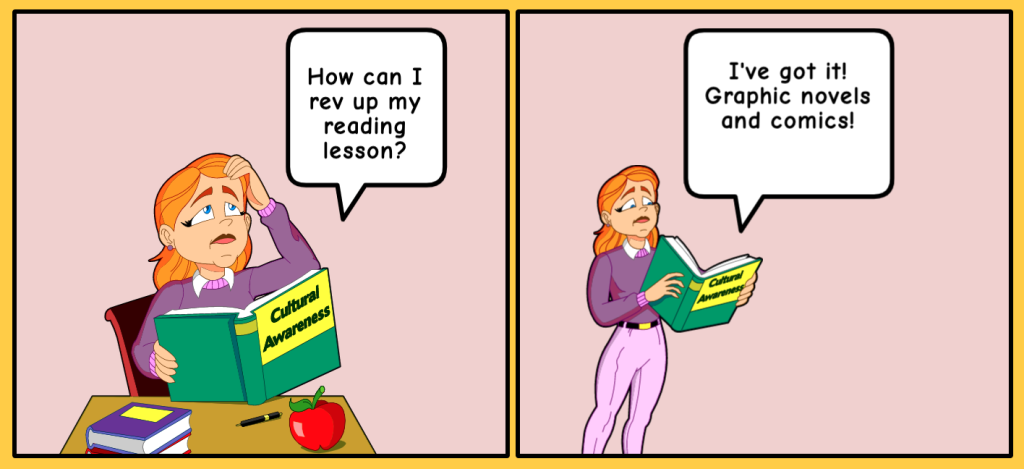
January is typically a time when people are looking forward – considering new goals and new approaches. In this post, however, I’ve decided to look back. I’m revisiting some of the information I gave in my very first professional development activity for TESL Ontario: a webinar I co-delivered in 2016 entitled Getting Animated: Graphic Novels in the ESL Classroom. My hope is that this blog will encourage readers to find ways to incorporate graphic novels and/or comics into their 2023 teaching practices.
Some key terms
To begin, I think it is prudent to share some useful terms to know when speaking about graphic novels
and comics:
- cartoon: a single panel (e.g., daily editorial cartoons published in newspapers)
- comic strip: a story of three to five panels (e.g., Garfield by Jim Davis)
- comic book: a comic strip that is 20 to 40 pages (e.g., the Spider-Man series by Marvel)
- graphic novel: a comic book that is more than 40 pages (e.g., Maus: A Survivor’s Tale by Art Spiegelman)
Some key benefits
Research has demonstrated a slew of advantages associated with teaching graphic novels and comics, but here I will highlight three.
Firstly, graphic novels and comics have the capacity to increase student motivation and desire to read.
Secondly, by having images and text together, students are able to make stronger predictions and reflections. It can also be easier for learners to recognize tone and bias.
Thirdly, graphic novels and comics portray versions of culture and history that are often not seen in textbooks. They are a source of authentic language that ESL learners are generally keen to discover.
Some suggested classroom activities
Below are four easy activities that can be used when teaching graphic novels or comics:
- create a title
- remove or add panels
- re-arrange panels
- re-write dialogue balloons
In the past, I have done all of these activities with the comic Hurdles, which is part of Derek Kirk Kim’s
2004 graphic novel Same Difference and Other Stories.
Here are the steps I have used when teaching Hurdles:
- Prior to class, print multiple copies of the comic.
- Cut and re-arrange the panels. Place the stacked panels in separate bags or connect them with paper clips. If working with a more advanced class, remove the second to last panel from the comic from each stack.
- In small groups during class, have the students put the panels in the correct order. If you have removed a panel, ask the students to indicate where there is a gap in the story.
- Once the groups think they have the correct order, have them confer with each other and reach a consensus.
- Confirm the correct panel order. If necessary, provide the missing panel.
- Discuss the story. What message is Derek Kirk Kim trying to convey?
- Ask the students to create a title for the story and explain their reasoning.
- Tell the students the real title of the comic. Why did Derek Kirk Kim choose Hurdles?
- If working with more advanced learners, ask the students to re-write the dialogue balloons for the second to last panel. How would the new dialogue change the ending of the story?
In my experience, students have really enjoyed reading Hurdles and doing these activities. It has generated a lot of interesting discussion.
If you would like to know more about using graphic novels in ESL classes (e.g., additional activities, specific graphic novel recommendations), I encourage you to view the archived TESL Ontario webinar I mentioned at the beginning of this blog. Also, check out Stephen Cary’s fantastic book Going Graphic: Comics at Work in the Multilingual Classroom.
